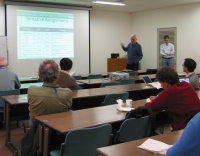 |
 |
|||||||||||||
|
|||||||||||||
|
|||||||||||||
|
The TILC08 meeting in Sendai saw the first gathering of the new Accelerator Advisory Panel (AAP). Other than the yet to be established Project Advisory Committee, which will be formed following a request from the International Linear Collider Steering Committee (ILCSC) and will consist mainly of machine and detector experts from outside the ILC community, the AAP is an internal body, there to advise the Global Design Effort director and to give critical recommendations. Chairman of the new group is Bill Willis of Columbia University, a GDE member of the first hour with lots of experience in not only real hands-on particle physics but also in large international collaborations and politics. He is accompanied by Eckhard Elsen of DESY, also an experimentalist-turned-machine expert. They called the first meeting of the group in a lunch break during the Sendai meeting, and almost all 11 members showed up, if only virtually: Hasan Padamsee and Jonathan Dorfan attended by Webex. The first meeting was used to start establishing a working procedure to maximise information exchange and minimise distraction of the project. The two chairs, working with the Executive Committee, had identified six themes to start with, all of them major areas of ongoing activities: strategic planning, civil construction, superconducting radio frequency (rf), beam delivery system / machine-detector interface / Accelerator Test Facility, damping rings and integration. Each theme is associated with a single GDE Project Manager (or, for integration, another member of the GDE management team) and with a single contact person in the AAP. This provides a simple interface for information exchange, supposed to minimise the workload of the project managers. “We developed this idea together with the Executive Committee,” explains Willis. “It follows a model suggested by project manager Akira Yamamoto, who has tried the theme of his own work on superconducting rf, and found it useful.” He teamed up with Hasan Padamsee of Cornell for a close collaboration between Project Manager and advisor during the last few months, including a trip to Japan for Padamsee. “It seems to be a good model, and now we will try it out on the other five areas.” Each project manager-contact person team will now specify the detailed working conditions and goals together. Their proposal goes to the AAP for comments before presenting it to the Executive Committee. Another suggestion of the Executive Committee was that the AAP should organise just two reviews of the project, one at the middle and one at the end of the first part of the ILC Technical Design Phase. They will probably call on outside experts to join the reviews. Their reviews will go into a lot of detail. “It will be an intense process,” Willis predicts. Willis does not see an overlap of the AAP mandate with that of the Project Advisory Committee: “The PAC works at a higher, less hands-on level and for instance has to cover accelerator and detectors. The ILC experience shows that our work tends to evolve on a timescale of months, and our group of contacts allows the AAP to stay in touch so that when the review is carried out, they are well informed about the project,” he says. “The PAC has the complementary strength of a fresh view.” -- Barbara Warmbein |
|||||||||||||
| © International Linear Collider |
